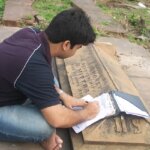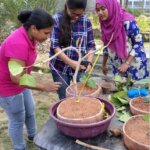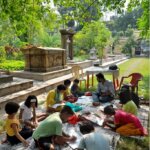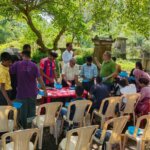‘A Practical Handbook for Historic Cemeteries in South Asia and Community Engagement’, written by Dr Neeta Das, has been added to BACSA’s range of publications.

Invaluable to anyone concerned with safeguarding a historic South Asian cemetery, this Handbook focuses on Community Engagement – essential to ensuring the cemetery’s long-term sustainability. It complements Dr Das’s Practical Handbook for the Care of Old Tombs and Cemeteries in South Asia (2020), which is aimed at people carrying out cemetery conservation work.
Dr Das explains the importance of obtaining the support of a cemetery’s wider community – starting with the owners, users and neighbours, then rippling out to include other people to whom the cemetery is relevant – such as visitors, researchers, students, municipal bodies, local and state governments, tourists and tourism agencies.
Identifying the cemetery’s specific problems, challenges and features – both man-made and natural – comes next:
•Are there any monuments, or inscriptions, of cultural or historic interest?
•Could the cemetery form part of a local heritage trail?
•What about ecological aspects – is the site a haven for birds, butterflies, moths or wildflowers?
•Does the cemetery layout lend itself to healthy walking, jogging and/or nature trails?
•Might there be some possible additional uses for the land – could outdoor events such as concerts, plays or poetry readings be held there? Yoga classes? Gardening classes?
•Or perhaps there is space for a plant nursery for growing – and selling – flowers, fruit and vegetables?

Photo: KSHT

Photo: KSHT
Helpfully, Dr Das includes Case Studies of five very different, successful projects illustrating these points:
•Lovedale Cemetery, Ootacamund – raises maintenance funds from the Lawrence School alumni
•South Park Street, Kolkata – has developed a nursery selling plants to help raise funds
•The Scottish Cemetery, Kolkata – has been developed as a biodiversity conservation urban park, and runs a community education programme for adults and children
•Wombwell Cemetery, South Yorkshire, UK – hosts a ‘Community Hub’ for local networks
•Kala Khani (‘Pines’) Cemetery, Naini Tal – incorporates a ‘Sensorium’, encouraging visitors to meditate in the peaceful surroundings and contemplate the gift of life, as perceived through the five senses.

Photo: KSHT

Photo: KSHT
The Handbook includes a Check List and Action Plan to help groups:
•Articulate their vision for a cemetery
•Publicise their proposals and obtain funding
•Develop an ongoing, sustainable maintenance plan, and
•Develop programmes of activities for schoolchildren, scholars, artists, actors, poets, writers, historians and musicians.
Click here and follow the link to download a free copy of ‘A Practical Handbook for Historic Cemeteries in South Asia and Community Engagement’. BACSA Members can read a review of Dr Das’s book by Mark Havelock-Allen in the Spring 2024 issue of Chowkidar (p.16).
Rachel Magowan
